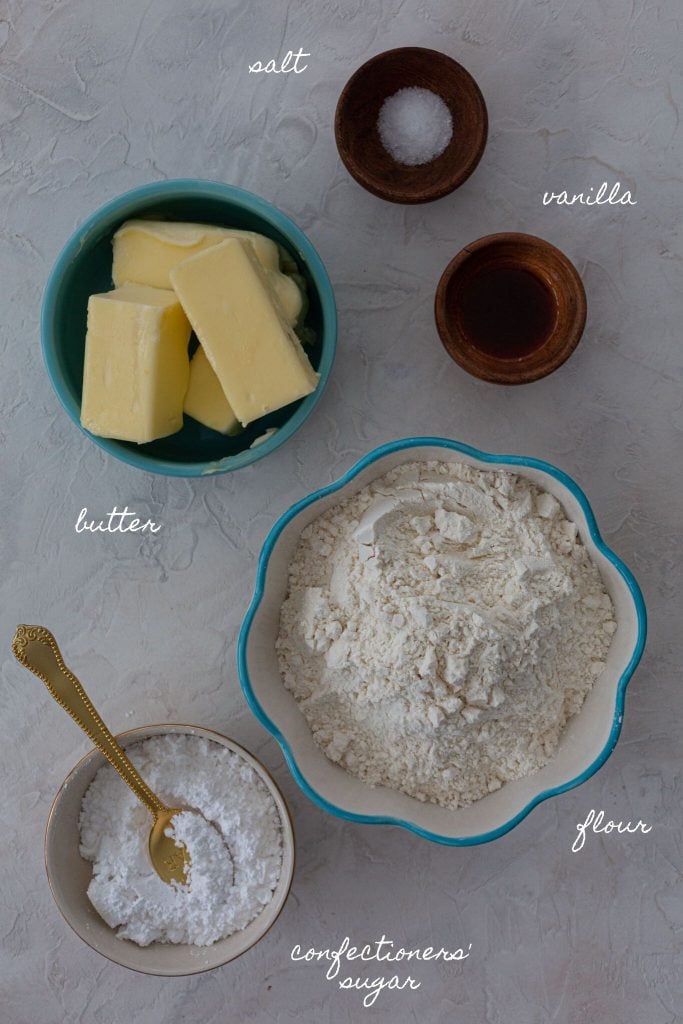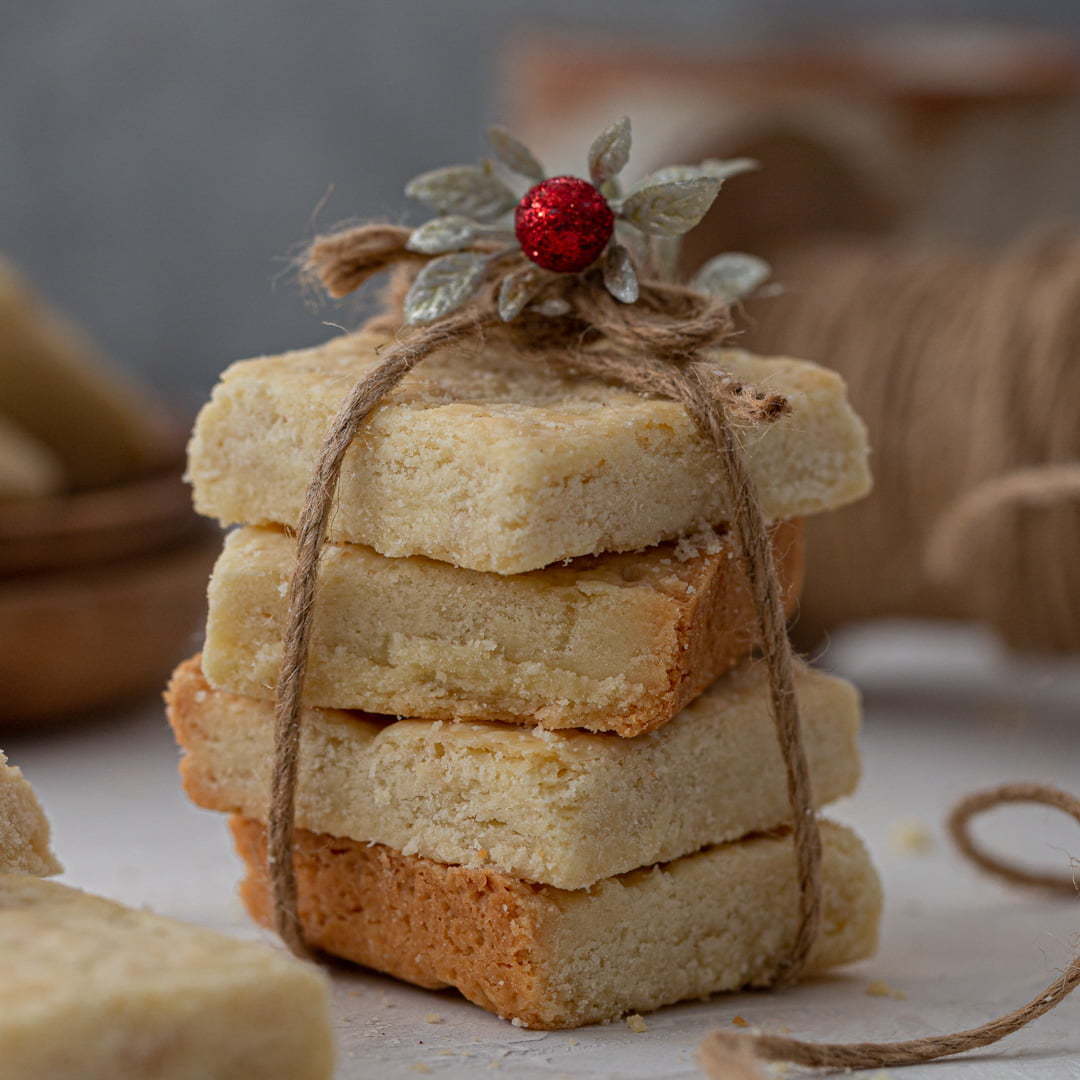How to make Shortbread Cookies
Melt in your mouth, buttery Scottish-style shortbread cookies are delicious year round, but especially great during the holidays! Enjoy the basic version or customize with add-ins, toppings or by dipping them in chocolate.
And to complete your Christmas cookie box, we have Dulce de Leche Linzer Cookies, Amaretti and Speculoos.

The easiest cookie recipe you will ever make!
I was recently faced with a difficult cookie situation. I completely forgot about a cookie exchange party that I had RSVP’d to and had to come up with freshly baked cookies in a matter of hours!
After I talked myself out of just buying the cookies, I asked myself: What type of cookie can be ready fast and doesn’t require a trip to the grocery store?
It was obvious. Shortbread cookies, of course!
The simplest yet always crowd-pleasing cookie of all time. Only a handful of ingredients, no chilling, no fancy cutters necessary.
Just mix, bake it and eat it! Or bring it to a cookie exchange party. It might not look as fancy as some of the other cookies, but nobody can resist the taste of buttery shortbreads!

What are shortbread cookies?
Shortbread is a traditional Scottish cookie, made originally from only sugar, butter and flour. It originated from medieval biscuit bread, which was a twice-baked, enriched bread dusted with sugar and hardened into a hard biscuit, called a rusk.
Eventually, yeast was replaced by butter and the shortbread was born!
The name “shortbread” comes from the large amount of butter that is characteristic to this cookie. The term short, in this context, means crumbly, and is a result from the fat inhibiting the formation of gluten.
Because of the butter, shortbread was expensive and reserved for special occasions, such as Christmas, weddings and Hogmanay (Scottish New Year’s Eve).
The cookies are traditionally cut into either rectangles (fingers), squares, triangles (petticoat tails) or rounds. But you can cut them in any shape you like!
Their popularity around the world can be credited to the Scottish brand Walkers Shortbread, the one packaged in the unmistakable tartan design.

To make basic shortbread cookies, you’ll need:
- Butter – the best one you can afford!
- Confectioners’ Sugar – or caster sugar if you can find/afford it.
- Flour
- Vanilla Extract
- Salt
Some people add rice flour for a sandier shortbread and other like cornflour for a nice melt-in-your-mouth effect. You should play around with it, if you like, until you achieve the shortbread of your dreams!
I’d start with a 3:1 ratio of plain flour to cornflour and increase (up to 1:1) if you think it could be softer! If you want to try the rice flour, you can use a 1:2 ratio of rice flour to plain. That will produce a crunchier, sandier cookie.
That being said, shortbread is perfectly fine the traditional way, made with all-purpose flour!

How to make shortbread cookies recipe
Let me start by saying there are many different recipes and variations for shortbread.
This shortbread cookies recipe is a favorite of mine because 1) it is easy/quick and 2) it produces cookies with a great crumbly texture and delicious buttery flavor.
Recommended equipment: stand mixer, square baking dish, paring knife.

Here’s the rundown of this shortbread cookies recipe. As always, you can find the printable version at the end of this post!
- Cream the butter, sugar and vanilla: Combine the three ingredients in a stand mixer fitted with the paddle attachment and run on medium speed until the mixture is smooth and fluffy.
- Add the flour and mix until it’s as combined as it will get. It will look like coarse breadcrumbs.
- Transfer the dough to a baking dish: Pour the mixture into a square baking pan and use your fingers to firmly press down the dough. Use the back of a spoon to smooth out the surface.
- Using the tip of a small paring knife, score the dough into 16 squares (or about 18 skinny rectangles), so they can be easily cut after baking.
- Prick the dough all over with a fork, to allow steam to escape while baking. You can play around with the patterns.
- Optional: chill for up to 30 minutes for the flavors to develop.
- Bake at 350 degrees F for 35-40 minutes or until light golden.
- Let it cool, then cut following the previously scored indentations.
If you prefer to cut the cookies in rounds – or fun shapes like hearts and starts – you can pat the dough into a disc and refrigerate for 30 minutes. Then roll until it is about 1/4-inch thick and cut into the desired shape using a lightly floured cookie cutter.
Place on a parchment paper lined baking sheet, chill again for another 15-30 minutes and bake as directed above. Baking time will vary, so start checking after 15 minutes!
Why do I have to prick shortbread?
Pricking the cookie dough with a fork allows any steam to escape while also preventing it from bubbling as it bakes. It also gives you the signature Scottish shortbread cookie design.
Does shortbread cookie dough need to be refrigerated?
It depends.
If you are cutting the cookies with a cutter and placing them individually on a baking sheet, I’d chill them for 15-30 minutes before baking.
The high fat content in these cookies cause the butter to melt quick in the oven, causing the cookies to spread. Chilling the cookies before baking solidifies the butter, meaning it will take longer for it to melt while it bakes. That gives the cookies a chance to firm up and lock up the fat content inside.
How long can I refrigerate cookie dough?
The cookie dough can be refrigerated for about 3 to 5 days. Make sure it is wrapped tightly, so it doesn’t absorb any weird fridge smells!

Can I freeze shortbread?
Yes! The high fat content in these cookies means they freeze really well. You can either:
- Freeze the cookie dough, wrapped tightly, for up to 3 months. Defrost overnight in the fridge or bake from frozen (if you’ve already placed in the baking dish).
- Freeze the baked cookies for up to a month. You will want to allow them to cool and then place them on a baking sheet, not touching, and freeze (tightly wrapped) until they are frozen solid. You can then transfer them to an airtight container or freezer bag.
Thaw them at room temperature, out of the containers, so condensation doesn’t form and make them soggy. You can then eat them or gently reheat for 10-15 minutes at 275 degrees F for that fresh-baked texture everybody loves!
Variations
Classic shortbread is always welcome in my house, but sometimes we like to shake things up a bit.
These are some of our favorite mix ins. I recommend adding about 1/4 cup or 1 tablespoon for the herbs/spices/cocoa powder/tea.
- Dried fruits: cranberries, figs, cherries
- Toasted chopped nuts
- Toasted coconut
- Mini chocolate chips
- Chopped herbs
- Cocoa powder
- Espresso powder
- Crushed peppermint
- Earl Grey or Chamomile (ground)
- Lemon zest

Classic Shortbread Cookies
Melt in your mouth, buttery Scottish-style shortbread cookies are delicious year round, but especially great during the holidays! Enjoy the basic version or customize with add-ins, toppings or by dipping them in chocolate.
Ingredients
- 2 sticks (226g) good quality butter, softened
- 3/4 cup (110g) confectioners' sugar
- 1 teaspoon vanilla extract
- 1/2 teaspoon salt
- 2 cups (307g) all-purpose flour
Instructions
- Preheat oven to 350 degrees F.
- Start by creaming together the butter, sugar and vanilla extract until smooth and fluffy. You can use a stand mixer, hand mixer or do it the traditional way: with a wooden spoon and some muscles!
- Add the flour and salt. Beat until combined. The dough won't be cohesive and will look more like coarse breadcrumbs.
- Transfer the dough to a lightly greased square (8x8 or 9x9) baking pan. Pat the dough until it is smooth and use the back of a spoon to smooth out any bumps.
- Using a sharp paring knife, score the dough into 16 squares, to make cutting easier after baking. Then, use a knife to prick it all over for the traditional Scottish design.
- Optional: chill for 30 minutes before baking.
- Bake for 35-40 minutes or until the edges are lightly browned.
- Let the cookies cool slightly on the pan before cutting and transferring to a wire rack so they can cool completely.
Notes
Other shapes:
- Fingers: just score the unbaked dough into skinny rectangles, just like the Walker Shortbread traditional shape.
- Petticoat tails: Instead of using a square baking dish, you will need a 9-inch springform pan. After mixing the dough, transfer to the counter, flatten into a disk and roll out between 2 sheets of parchment paper to about 1/2-inch thick. Transfer to the prepared pan, pressing evenly on the pan. Score into 8 equal triangles and pierce with a fork. Proceed with the rest of the recipe.
- Round, hearts, starts and other fun shapes: After mixing the dough, transfer to the counter and flatten into a disk. Wrap and refrigerate for 30 min, then roll out between 2 sheets of parchment paper to about 1/2-inch thick. Cut using lightly floured cookie cutters and transfer the cookies onto a parchment paper line baking sheet. Chill again for 15-30 min. Bake until lightly golden brown (baking times will vary according to size of cookies).
Shelf life:
Shortbread cookies will keep at room temperature, stored in an airtight container, for up to 1 week.
Freezing:
You can freeze the cookie dough for up to 3 months or the baked cookies for up to 1 month.
Recommended Products
As an Amazon Associate and member of other affiliate programs, I earn from qualifying purchases.
Nutrition Information:
Yield: 16 Serving Size: 1Amount Per Serving: Calories: 71Total Fat: 2gSaturated Fat: 1gTrans Fat: 0gUnsaturated Fat: 1gCholesterol: 4mgSodium: 78mgCarbohydrates: 12gFiber: 0gSugar: 0gProtein: 2g
Nutritional values are approximate, please use your own calculations if you require a special diet.







